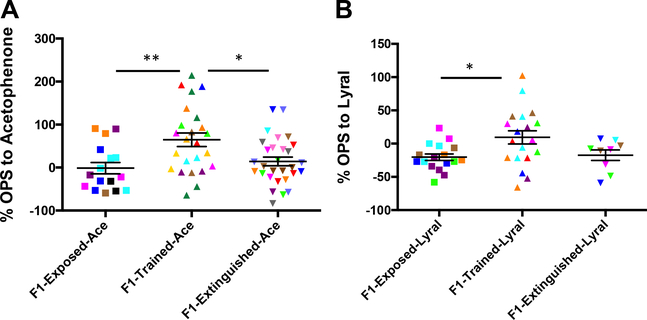Figure 1.
Reversal of behavioral sensitivity of salient parental olfactory experience tested using odor-potentiated startle (OPS). (A) Parent generation (F0) male mice treated with acetophenone (Ace) and future generation (F1) mice tested with Ace. Exposing F0 male mice that had been previously fear conditioned with Ace to extinction training (F1-Exposed-Ace), which decreases their fear toward Ace), results in F1-Extinguished-Ace offspring that did not demonstrate behavioral sensitivity to Ace, as is observed in the F1-Trained-Ace cohort. As we have reported previously, F1-Trained-Ace animals sired by F0 male animals that had been conditioned with Ace + mild foot shocks show a higher sensitivity to Ace compared with F1-Exposed-Ace animals sired by F0 male animals that had been exposed only to Ace presentations. (B) F0 male mice treated with Lyral and F1 mice tested with Lyral. F1-Trained-Lyral animals sired by F0 male mice that had been conditioned with Lyral + mild foot shocks showed a higher sensitivity to Lyral compared with F1-Exposed-Lyral animals sired by F0 male mice that had been exposed only to Lyral presentations. Exposing F0 male mice that had been previously fear conditioned with Lyral to extinction training resulted in F1-Extinguished-Lyral offspring that did not demonstrate behavioral sensitivity to Lyral, as is observed in the F1-Trained-Lyral cohort. Data are presented as mean ± SEM. *p < .05, **p < .01. Same colorswithin a group represent individuals from the same litter.

